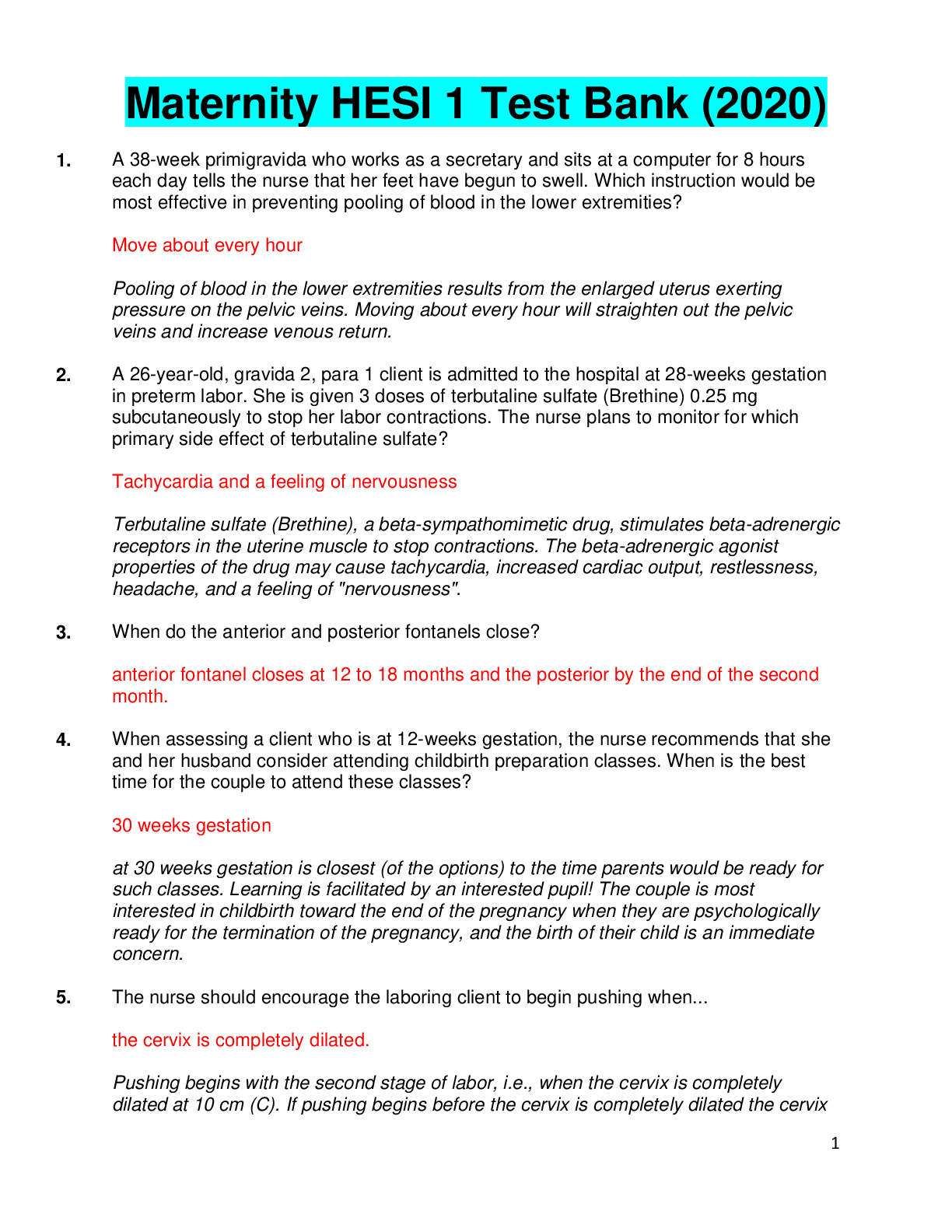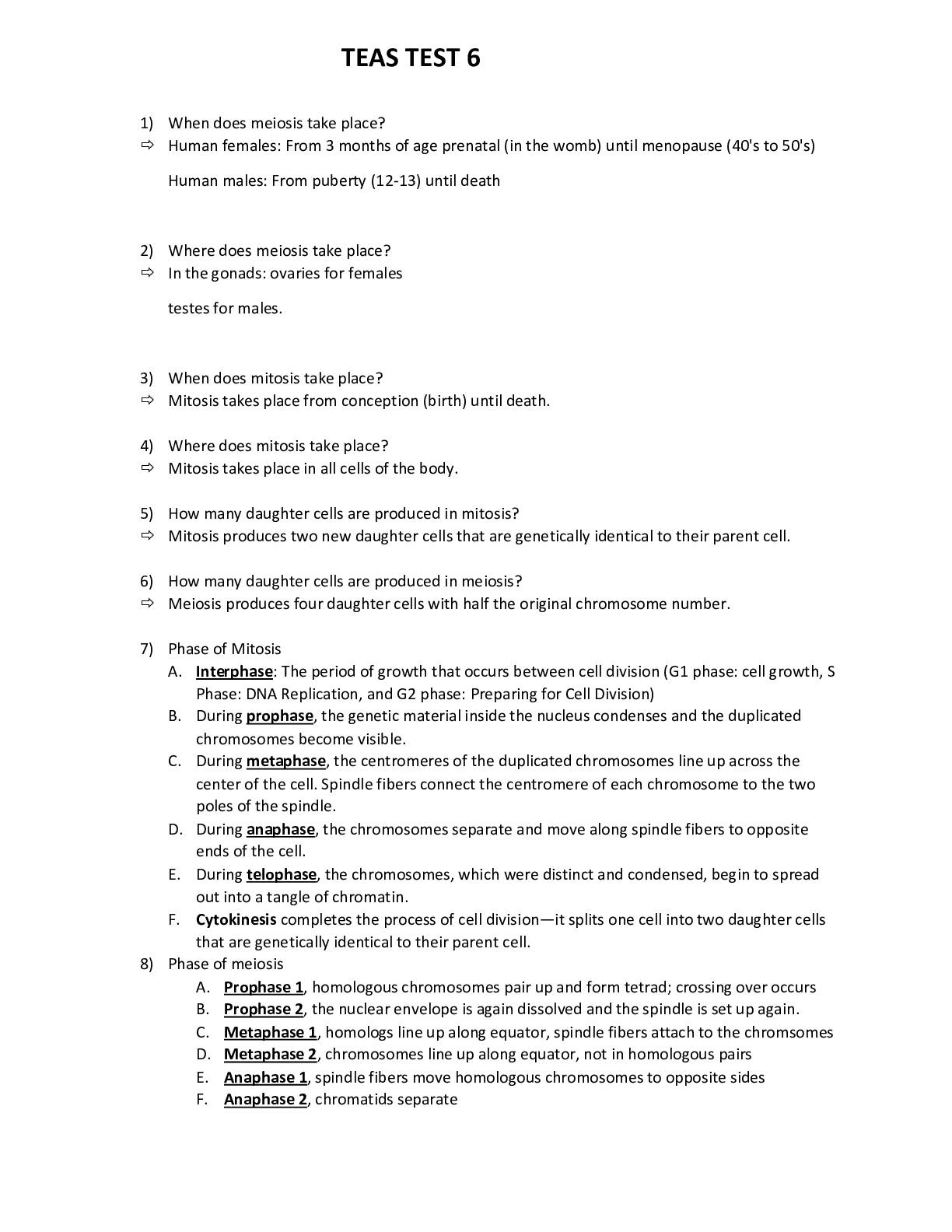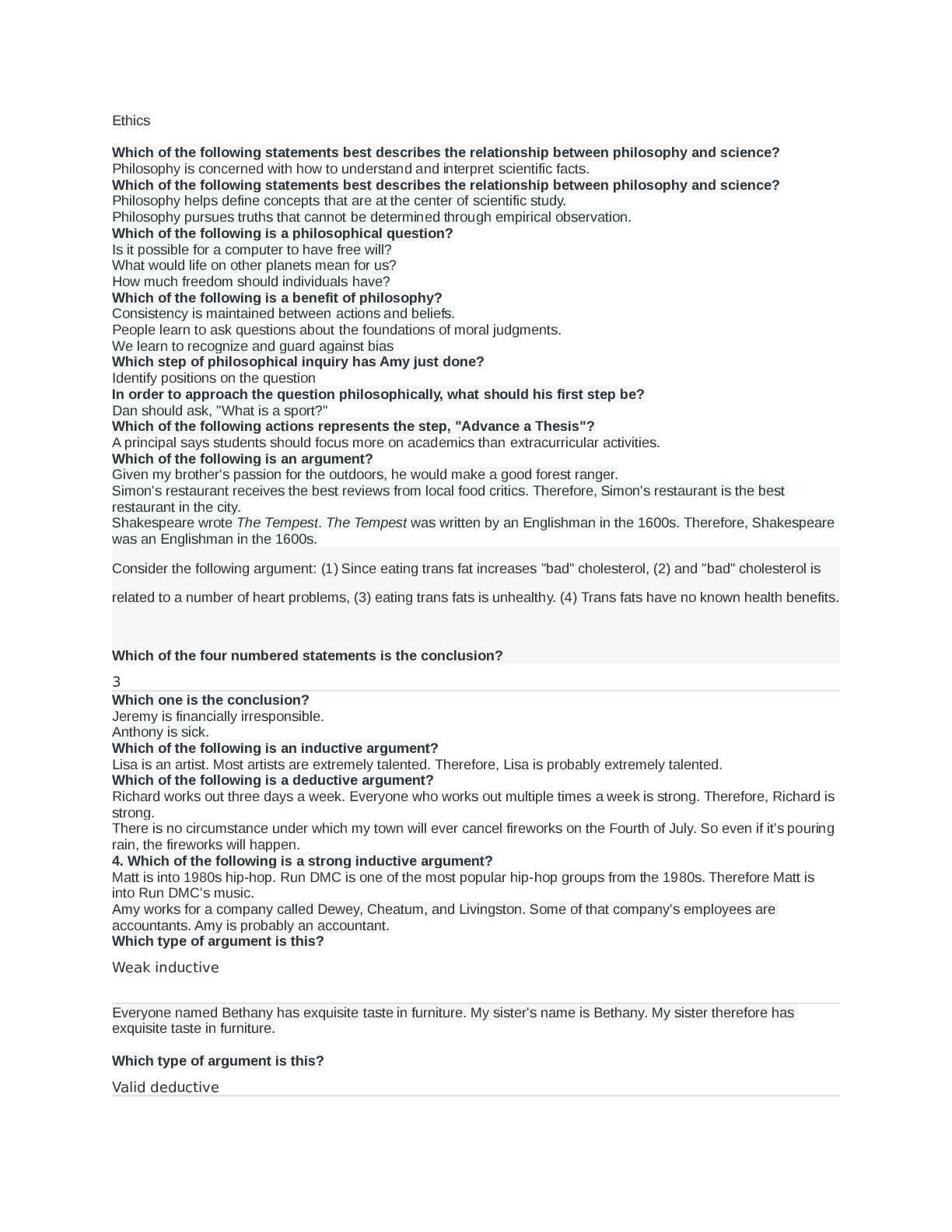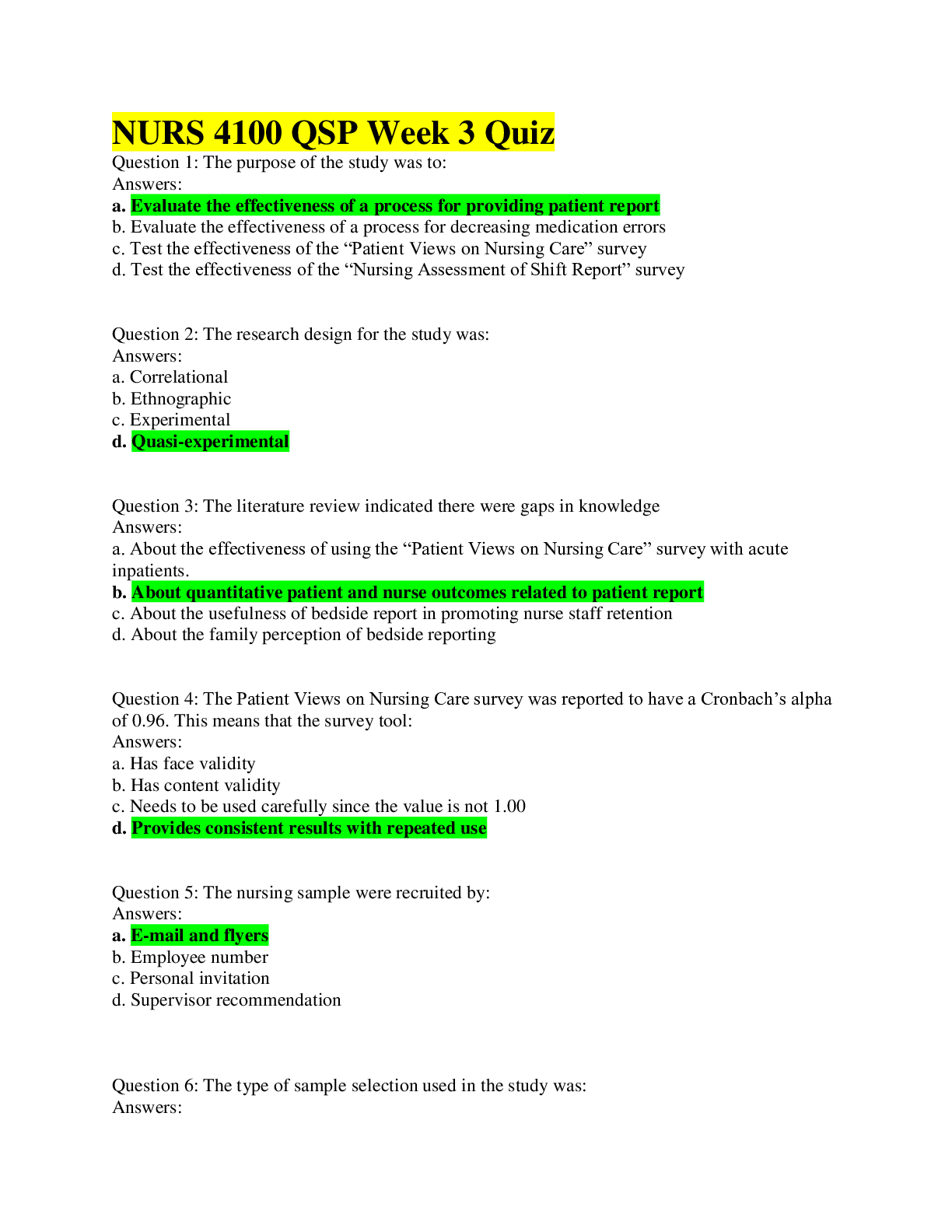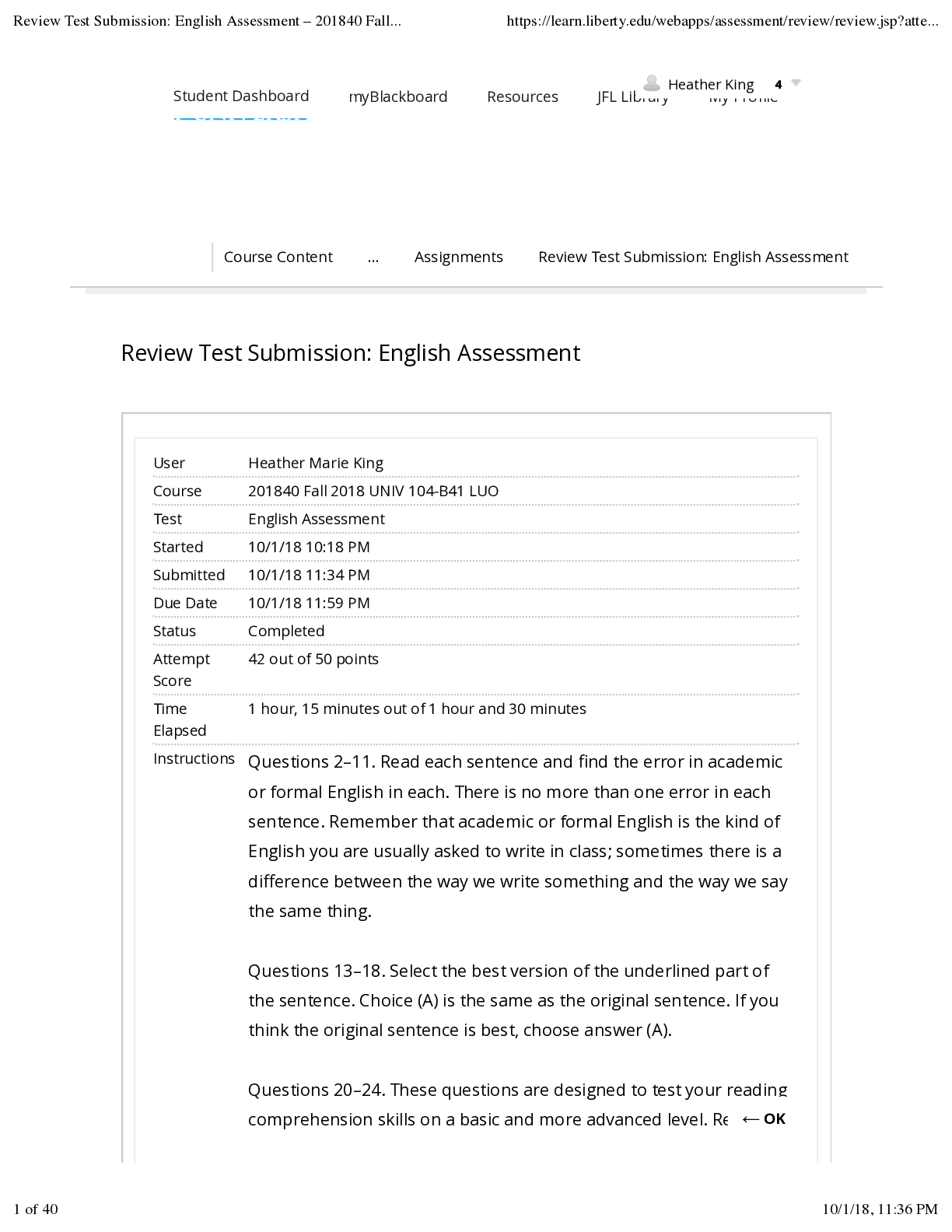*NURSING > QUESTIONS & ANSWERS > NURS 6531 Final Exam, (2 versions) Latest update 2019/2020. (All)
NURS 6531 Final Exam, (2 versions) Latest update 2019/2020.
Document Content and Description Below
NURS 6531 Final Exam 2019/20 • Question 2 Central obesity, “moon” face, and dorsocervical fat pad are associated with: A. Metabolic syndrome B. Unilateral pheochromocytoma C. ... Cushing’s syndrome D. None of the above • Question 3 An elderly man is started on lisinopril and hydrochlorhiazide for hypertension. Three days later, he returns to the office complaining of left great toe pain. On exam, the nurse practitioner notes an edematous, erythematous tender left great toe. The likely precipitant of this patient’s pain is: A. Trauma B. Tight shoes C. Arthritis flare D. Hydrochlorothiazide • Question 4 The most effective treatment of non-infectious bursitis includes: • Question 5 What conditions must be met for you to bill “incident to” the physician, receiving 100% reimbursement from Medicare? The physician must be on-site and engaged in patient care You must initiate the plan of care for the patient The physician must be on-site and engaged in patient care You must be employed as an independent contractor You must be the main health care provider who sees the patient • Question 6 Which of the following is not a risk factor associated with the development of syndrome X and type 2 diabetes mellitus? • Question 7 Which of the following is not a common early sign of benign prostatic hyperplasia (BPH)? A. Nocturia B. Urgency incontinence C. Strong urinary stream flow D. Straining to void • Question 8 Steve, age 69, has gastroesophageal reflux disease (GERD). When teaching him how to reduce his lower esophageal sphincter pressure, which substances do you recommend that he avoid? • Question 9 Which drug category contains the drugs that are the first line Gold standard therapy for COPD? • Question 10 The most commonly recommended pharmacological treatment regimen for low back pain (LBP) is: • Question 11 Which of the following is not appropriate suppression therapy for chronic bacterial prostatitis? • Question 12 A patient presents with dehydration, hypotension, and fever. Laboratory testing reveals hyponatremia, hyperkalemia, and hypoglycemia. These imbalances are corrected, but the patient returns 6 weeks later with the same symptoms of hyperpigmentation, weakness, anorexia, fatigue, and weight loss. What action(s) should the nurse practitioner take? .A Obtain a thorough history and physical, and check serum cortisol and ACTH levels. B. Perform a diet history and check CBC and FBS. C. Provide nutritional guidance and have the patient return in one month. D. Consult home health for intravenous administration 1. • Question 16 You are assessing a patient after a sports injury to his right knee. You elicit a positive anterior/posterior drawer sign. This test indicates an injury to the: he A. lateral meniscus B. cruciate ligament C. medial meniscus D. collateral ligament. • Question 17 A 32 year old female patient presents with fever, chills, right flank pain, right costovertebral angle tenderness, and hematuria. Her urinalysis is positive for leukocytes and red blood cells. The nurse practitioner diagnoses pyelonephritis. The most appropriate management is: • Question 19 A middle-aged man presents to urgent care complaining of pain of the medial condyle of the lower humerus. The man works as a carpenter and describes a gradual onset of pain. On exam, the medial epicondyle is tender and pain is increased with flexion and pronation. Range of motion is full The most likely cause of this patient’s pain is: • Question 21 The best test to determine microalbuminuria to assist in the diagnosis of diabetic neuropathy • Question 22 What is the first symptom seen in the majority of patients with Parkinson’s disease? • Question 23 The most commonly recommended method for prostate cancer screening in a 55 year old male is: • Question 24 Martin, age 24, presents with an erythematous ear canal, pain, and a recent history of swimming. What do you suspect? • Question 25 Which of the following symptoms suggests a more serious cause of back pain? • Question 28 A patient taking levothyroxine is being over-replaced. What condition is he at risk for? • Question 29 Which of the following is the most common cause of low back pain? A. Lumbar disc disease B. Spinal stenosis C. Traumatic fracture D. Osteoporosis • Question 30 Which is the most common cause of end-stage renal disease in the United States? • Question 31 A 77-year-old female presents to the office complaining a sudden swelling on her right elbow. She denies fever, chills, trauma, or pain. The physical exam reveals a non-tender area of swelling over the extensor surface over the right elbow with evidence of trauma or irritation. The nurse practitioner suspects: A. Arthritis B. Ulnar neuritis C. Septic arthritis D. Olecranon bursitis • Question 32 A 60 year old female patient complains of sudden onset unilateral, stabbing, surface pain in the lower part of her face lasting a few minutes, subsiding, and then returning. The pain is triggered by touch or temperature extremes. Physical examination is normal. Which of the following is the most likely diagnosis? • Question 33 Beth, age 49, comes in with low back pain. An x-ray of the lumbosacral spine is within normal limits. Which of the following diagnoses do you explore further? • Question 34 • D A patient exhibits extrapyramidal side effects of antipsychotic medications. Which of the following symptoms would lead you to look for another diagnosis? • Question 35 Phalen’s test, 90°wrist flexion for 60 seconds, reproduces symptoms of: • Question 37 The most common cause of elevated liver function tests is: • Question 38 Reed-Sternberg B lymphocytes are associated with which of the following disorders: A. Aplastic anemia B. Hodgkin’s lymphoma C. Non Hodgkin’s lymphoma D. Myelodysplastic syndromes • Question 39 Which of the following is a potential acquired cause of thrombophilia? A. Homocysteinuria B. Protein C deficiency C. Factor V Leiden D. Antiphospholipid antibodies • Question 41 A 75-year-old female is diagnosed with primary hyperparathyroidism and asks the nurse practitioner what the treatment for this disorder is. The nurse practitioner explains: Primary hyperparathyroidism is treated with Vitamin D restriction Primary hyperparathyroidism is treated with parathyroidectomy Primary hyperparathyroidism is treated with daily magnesium Primary hyperparathyroidism is treated with parenteral parathyroid hormone (PTH) • Question 43 A 25 year old overweight patient presents with a complaint of dull achiness in his groin and history of a palpable lump in his scrotum that “comes and goes”. On physical examination, the nurse practitioner does not detect a scrotal mass. There is no tenderness, edema, or erythema of the scrotum, the scrotum does not transilluminate. What is the most likely diagnosis? A. Testicular torsion B. Epididymitis C. Inguinal hernia D. Varicocele • Question 44 Dave, age 38, states that he thinks he has an ear infection because he just flew back from a business trip and feels unusual pressure in his ear. You diagnose barotrauma. What is your next action? A. Prescribe nasal steroids and oral decongestants B. Prescribe antibiotic eardrops C. Prescribe systemic eardrops D. Refer David to an ear, nose, and throat specialist A. Prescribe • Question 46 The physiological explanation of syncope is: • Question 47 A 20 year old male patient complains of “scrotal swelling.” He states his scrotum feels heavy, but denies pain. On examination, the nurse practitioner notes transillumination of the scrotum. What is the most likely diagnosis? • Question 48 A 32 year old male patient complains of urinary frequency and burning on urination for 3 days. Urinalysis reveals bacteriuria. He denies any past history of urinary tract infection. The initial treatment should be: nclude nitrofurantoin monohydrate/macrocrystals, trimethoprim-sulfamethoxazole (TMP-SMX), or fosfomycin. • Question 49 Diagnostic radiological studies are indicated for low back pain: • Question 51 An 81-year-old female is diagnosed with type 2 diabetes. When considering drug therapy for this patient, the nurse practitioner is most concerned with which of the following side effects? A. Weight gain B. Fracture risk C. Hypoglycemia D. Weight loss • Question 53 The diagnosis of human papilloma virus (HPV) infection in males is usually made by: • Question 54 Which history is commonly found in a patient with glomerulonephritis? • Question 55 A patient complains of generalized joint pain and stiffness associated with activity and relieved with rest. This patient history is consistent with which of the following disorders? • Question 56 The most common presentation of thyroid cancer is: • Question 57 The obligatory criteria for diagnosis of muscular dystrophy (MD) are: case for genetic diagnosis. • Question 58 The diagnosis which must be considered in a patient who presents with a severe headache of sudden onset, with neck stiffness and fever, is: • Question 59 A 60 year old male patient with multiple health problems presents with a complaint of erectile dysfunction (ED). Of the following, which medication is most likely to be causing the problem? • Question 60 A 72 year old patient exhibits sudden onset of fluctuating restlessness, agitation, confusion, and impaired attention. This is accompanied by visual hallucinations and sleep disturbance. What is the most likely cause of this behavior? A. Dementia B. Delirium C. Parkinson's disease D. Depression • Question 61 Which of the following set of symptoms should raise suspicion of a brain tumor? • Question 62 The cornerstone of treatment for stress fracture of the femur or metatarsal stress fracture is: • Question 63 Sally, a computer programmer, has just been given a new diagnosis of carpal tunnel syndrome. Your next step is to: a. refer her to a hand surgeon b. take a more complete hx c. try neutral position wrist splinting and order an oral NSAID d. order a nerve conduction study such as an electromyography (EMG) • Question 64 Marsha presents with symptoms resembling both fibromyalgia and chronic fatigue syndrome, which have many similarities. Which of the following is more characteristic of fibromyalgia? A. Musculosckeletal pain B. Difficulty sleeping C. Depression D. Fatigue • Question 65 The cardinal sign of infectious arthritis is: • Question 66 Diagnostic evaluation for urinary calculi includes: • Question 70 A 15 year-old female patient is 5 feet tall and weighs 85 pounds. You suspect anorexia and know that the best initial approach is to: • Question 71 A 63-year-old man presents to the office with hematuria, hesitancy, and dribbling. Digital rectal exam (DRE) reveals a moderately enlarged prostate that is smooth. The PSA is 1.2. What is the most appropriate management strategy for you to follow at this time? A. Prescribe an alpha adrenergic blocker. B. Recommend saw palmetto. C. Prescribe an antibiotic D. Refer the client to urology. • Question 73 A positive drawer sign supports a diagnosis of: • Question 75 A 14 year old female cheerleader reports gradual and progressive dull anterior knee pain, exacerbated by kneeling. The nurse practitioner notes swelling and point tenderness at the tibial tuberosity. X-ray is negative. What is the most likely diagnosis? • Question 77 Jack, age 55, comes to the office with a blood pressure of 144/98 mm Hg. He states that he did not know if it was ever elevated before. When you retake his blood pressure at the end of the exam, it remains at 144/98. What should your next action be? • Question 79 Martin is complaining of erectile dysfunction. He also has a condition that has reduced arterial blood flow to his penis. The most common cause of this condition is: • Question 80 Successful management of a patient with attention deficit hyperactivity disorder (ADHD) may be achieved with: • Question 81 What diabetic complications result from hyperglycemia? 1. 1. 1. Retinopathy 2. Hypertension resistant to treatment 3. Peripheral neuropathy 4. Accelerated atherogenesis 5. • Question 82 In which of the following presentations is further diagnostic testing not warranted? • Question 83 The most common symptoms of transient ischemic attack (TIA) include: • Question 85 Establishment of a definitive diagnosis of osteomyelitis requires: • Question 86 Which of the following is the most common causative organism of nongonococcal urethritis? A. Chlamydia trachomatis B. Ureaplasma urealyticum C. Mycoplasma hominis D. Trichonomas vaginalis • Question 88 A 30 year old female patient presents to the clinic with heat intolerance, tremors, nervousness, and weight loss inconsistent with increased appetite. Which test would be most likely to confirm the suspected diagnosis? • Question 90 Potential causes of hypocalcemia include which of the following? • Question 92 Which of the following is a contraindication for metformin therapy? • Question 93 The organism most often associated with prostatitis is: A. Klebsiella B. Neiserria gonorrhoaes C. Chlamydia trachomatis D. Escherichia coli • Question 94 The most effective intervention(s) to prevent stroke is (are): • Question 95 What is the most commonly abused substance? • Question 98 An obese hyperlipidemic patient, newly diagnosed with type 2 diabetes mellitus, has fasting glucose values 180 to 250 mg/Dl. What is the most appropriate initial treatment to consider? A. A low-calorie diet and exercise B. Sliding-scale NPH insulin every 12 hours C. A sulfonylurea and/or metformin (Glucophage® -XR) D. Sliding-scale regular insulin every 6 hours • Question 100 Prolonged PT suggests: A. Platelet abnormality B. Abnormality in intrinsic coagulation pathway C. Abnormality in extrinsic coagulation pathway D. None of the above • Question 101 A patient presenting for an annual physical exam has a BMI of 25 kg/m2 This patient would be classified as: • Question 2 A patient presents with dehydration, hypotension, and fever. Laboratory testing reveals hyponatremia, hyperkalemia, and hypoglycemia. These imbalances are corrected, but the patient returns 6 weeks later with the same symptoms of hyperpigmentation, weakness, anorexia, fatigue, and weight loss. What action(s) should the nurse practitioner take? Question 5 Which of the following is a potential acquired cause of thrombophilia? Question 8 Differential diagnosis of proteinuria includes which of the following? 1. • Question 10 Question 35 The nurse practitioner diagnoses epididymitis in a 24 year old sexually active male patient. The drug of choice for treatment of this patient is: • Question 11 How do you respond when Jessica, age 42, asks you what constitutes a good minimum cardiovascular workout? • Question 12 The intervention known to be most effective in the treatment of severe depression, with or without psychosis, is: • Question 21 Which of the following accounts for half of the bladder tumors among men and one-third in women? • Question 23 A 21-year-old female presents to the office complaining of urinary frequency and urinary burning. The nurse practitioner suspects a urinary tract infection when the urinalysis reveals • Question 26 The initial clinical sign of Dupuytren’s contracture is: • Question 33 A nurse practitioner diagnoses a 60 year old male with balanitis. Which disease is commonly associated with balanitis? ( • Question 34 Josh, age 22, is a stock boy and has an acute episode of low back pain. You order and NSAID and tell him which of the following? • Question 35 A 72 year old female patient reports a 6 month history of gradually progressive swollen and painful distal interphalangeal (DIP) joints of one hand. She has no systemic symptoms but the erythrocyte sedimentation rate (ESR), antinuclear antibody (ANA), and rheumatoid factor (RF) are all minimally elevated. What is the most likely diagnosis? • Question 40 Jennifer says that she has heard that caffeine can cause osteoporosis and asks you why. How do you respond? "A high caffeine intake has a diuretic effect that may cause calcium to be excreted more rapidly." • Question 41 Which of the following set of symptoms should raise suspicion of a brain tumor? Holocranial headaches present in the morning and accompanied by projectile vomiting without nausea • Question 43 Diagnostic confirmation of acute leukemia is based on: Bone marrow aspiration and biopsy • Question 44 Which of the following antibiotics should not be prescribed for a pregnant woman in the 3rd trimester? Trimethoprim-sulfamethoxazole • Question 46 Who is at a higher risk for developing nephrolithiasis? Bill, who runs every day and takes excessive amounts of vitamin C • Question 53 A 28-year-old female presents to the office requesting testing for diagnosis of hereditary thrombophilia. Her father recently had a deep vein thrombosis and she is concerned about her risk factors. The nurse practitioner explains that: • Question 54 Martin, a 58 year old male with diabetes, is at your office for his diabetes follow up. On examining his feet with monofilament, you discover that he has developed decreased sensation in both feet. There are no open areas or signs of infection on his feet. What health teaching should Martin receive today regarding the care if his feet? • Question 57 Potential causes of septic arthritis include which of the following • Question 58 Which of the following is the best response to a woman who has just admitted she is a victim of spousal abuse • Question 62 A patient has been diagnosed with generalized anxiety disorder (GAD). Which of the following medications may be used to treat generalized anxiety disorder? • Question 64 Sam, age 67, is a diabetic with worsening renal function. He has frequent hypoglycemic episodes, which he believes means that his diabetes is getting “better.” How do you respond? • Question 67 A 35 year old male presents with a complaint of low pelvic pain, dysuria, hesitancy, urgency, and reduced force of stream. The nurse practitioner suspects acute bacterial prostatitis. Which of the following specimens would be least helpful for diagnosis? 1. • Question 69 A patient has just been diagnosed with Bell’s palsy. He is understandably upset and has questions about the prognosis. You response should be: • Question 70 What is the first step in the treatment of uric acid kidney stones? • Question 71 Urine cultures should be obtained for which of the following patients? • Question 73 A patient has been diagnosed with hypothyroidism and thyroid hormone replacement therapy is prescribed. How long should the nurse practitioner wait before checking the patient’s TSH? • Question 76 Which of the following patients most warrants screening for hypothyroidism? • Question 77 The hallmark of neurofibromatosis (von Recklinghausen’s disease) present in almost 100% of patients is: • Question 82 A patient presenting for an annual physical exam has a BMI of 25 kg/m2 This patient would be classified as: • Question 84 Diagnostic evaluation of hypothyroidism reveals: • Question 85 Diagnostic radiological studies are indicated for low back pain: • Question 88 The correct treatment for ankle sprain during the first 48 hours after injury includes: • Question 89 The most reliable indicator(s) of neurological deficit when assessing a patient with acute low back pain is(are): • Question 91 Risk factors for Addison’s disease include which of the following? • Question 92 Major depression occurs most often in which of the following conditions? • Question 93 Which of the following medications increase the risk for metabolic syndrome? • Question 97 A 27 year old female patient with epilepsy is well controlled with phenytoin (Dilantin). She requests information about contraception. The nurse practitioner should instruct her that while taking phenytoin: • Question 98 Risk factors for prostate cancer include all of the following except: • Question 101 Maria, age 17, was raped when she was 13 year old. She is now experiencing sleeping problems, flashbacks, and depression. What is your initial diagnosis? • Question 5 Diabetes screening recommendations for asymptomatic adults age 45 and over include which of the following: • Question 9 A child with type 1 diabetes mellitus has experienced excessive hunger, weight gain and increasing hyperglycemia. The Somogyi effect is suspected. What steps should be taken to diagnose and treat this condition? -------------------------------------------- • Question 10 Potential side effects of levofloxacin include which of the following? • Question 12 Which of the following is the most common complication of the myelodysplastic syndromes? • Question 15 Which of the following is characteristic of a manic episode? • Question 16 Which of the following characteristics are associated with prepatellar bursitis? • Question 20 A middle-aged female presents complaining of recent weight loss. The physical exam reveals an enlarged painless cervical lymph node. The differential diagnosis for this patient’s problem includes: • Question 21 What is the most common cause of Cushing’s syndrome? • Question 26 A diabetic patient is taking low-dose enalapril for hypertension. A record of the patient’s blood pressure over 4 weeks ranges from 130 to 142 mmHg systolic and 75 to 85 mmHg diastolic. How should the nurse practitioner respond? • Question 30 Your patient has an elevated mean cell volume (MCV). What should you be considering in terms of diagnosis? • Question 31 What information should patients with diabetes and their families receive about hypoglycemia? …………………. • Question 35 At what age is screening most likely to detect scoliosis? • Question 38 A patient has been taking fluoxetine (Prozac) since being diagnosed with major depression, first episode, 2 months ago. She reports considerable improvement in her symptoms and her intention to discontinue the medication. What should be the nurse practitioner’s recommendation? • Question 39 A typical description of a tension headache is: • Question 41 Which of the following is not a characteristic of type 2 diabetes mellitus? ----------------------------------- Which of the following is not a characteristic of type 1 diabetes mellitus? • Question 42 The most accurate measure of diabetes control is: • Question 43 Microalbuminuria is a measure of: • Question 53 A patient has HIV infection and is having a problem with massive diarrhea. You suspect the cause is: • Question 56 The nurse practitioner is following a child with juvenile rheumatoid arthritis (JRA) who has been previously diagnosed and is being managed for the disease by a pediatric rheumatologist. The mother asks for information about the child’s long term prognosis. What is the most appropriate reply? • Question 59 Which factors are associated with high risk for foot complications in a patient with diabetes mellitus? 1. Obesity 2. Abnormal nails 3. Abnormal gait Poorly controlled lipids Obesity 2.Abnormal nails 3.Abnormal gait 4. 4.Poorly controlled lipids 5. • Question 60 Which of the following is the most common causative organism of nongonococcal urethritis? • Question 61 A 65 year old patient complains of recurrent bilateral temporal headaches, malaise, muscle aches, and low grade fever. The headache is described as superficial tenderness rather than deep pain. Giant cell arteritis is suspected. Appropriate treatment is: • Question 64 The most reliable diagnostic indicator of gout is • Question 82 A patient with HIV infection has a fever of unknown origin (FUO). Which of the following is a possible cause of FUO in a patient with HIV? • Question 85 After treating a patient for Helicobacter pylori infection, what test do you order to see if it has been cured? A • Question 86 Which of the following physical modalities recommended for treatment of rheumatoid arthritis provides the most effective long term pain relief? • Question 88 Other than smoking cessation, which of the following slows the progression of COPD in smokers? • Question 93 What intervention does the American College of Rheumatology recommend as first line therapy for osteoarthritis? • Question 97 The best test to determine microalbuminuria to assist in the diagnosis of diabetic neuropathy: • Question 99 A 26 year old female presents with elbow pain that is described as aching and burning. There is point tenderness along the lateral aspect of the elbow and painful passive flexion and extension. She reports she has been playing tennis almost daily for the past month. The most likely diagnosis is: [Show More]
Last updated: 1 year ago
Preview 1 out of 31 pages
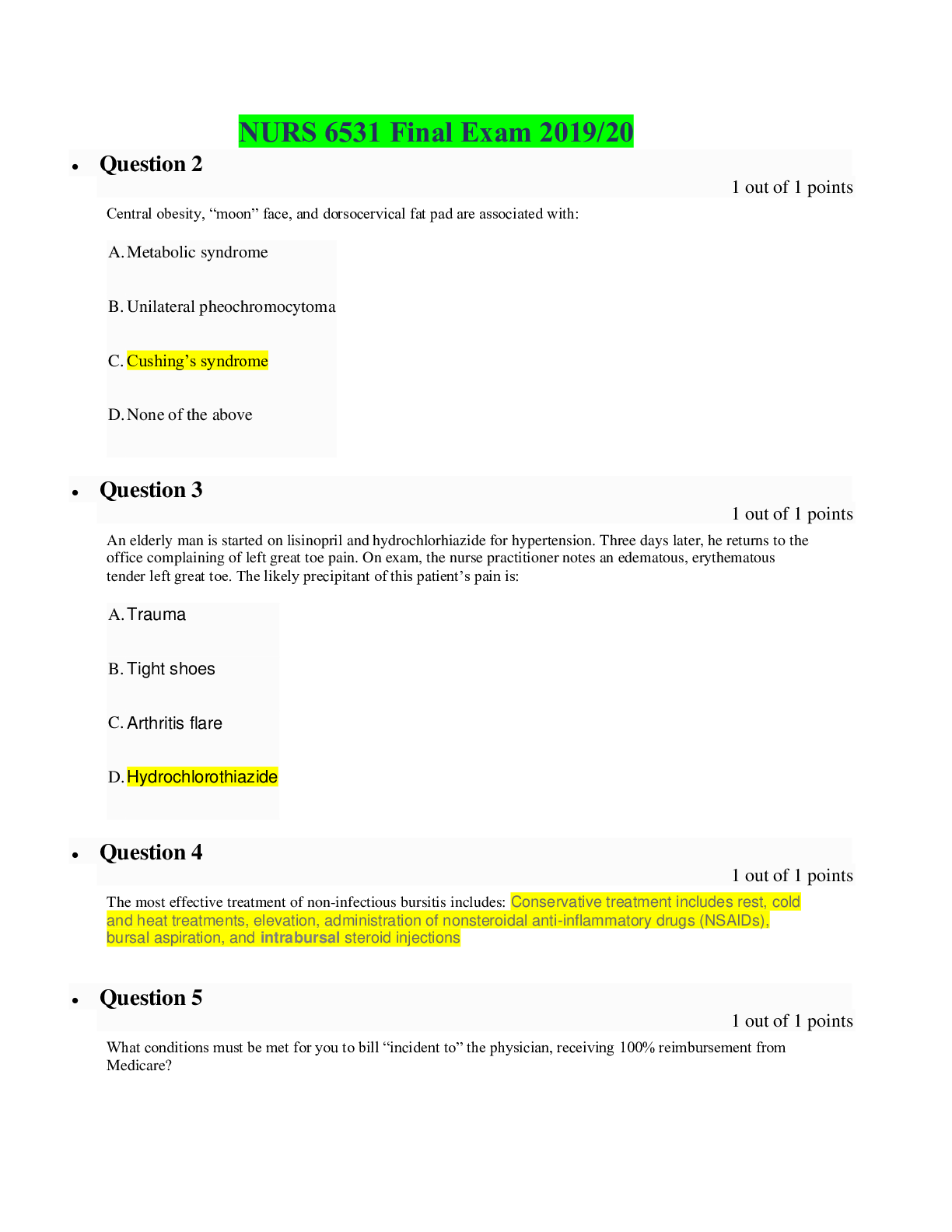
Buy this document to get the full access instantly
Instant Download Access after purchase
Add to cartInstant download
We Accept:

Reviews( 0 )
$15.00
Document information
Connected school, study & course
About the document
Uploaded On
Apr 14, 2020
Number of pages
31
Written in
Additional information
This document has been written for:
Uploaded
Apr 14, 2020
Downloads
0
Views
64

.png)



